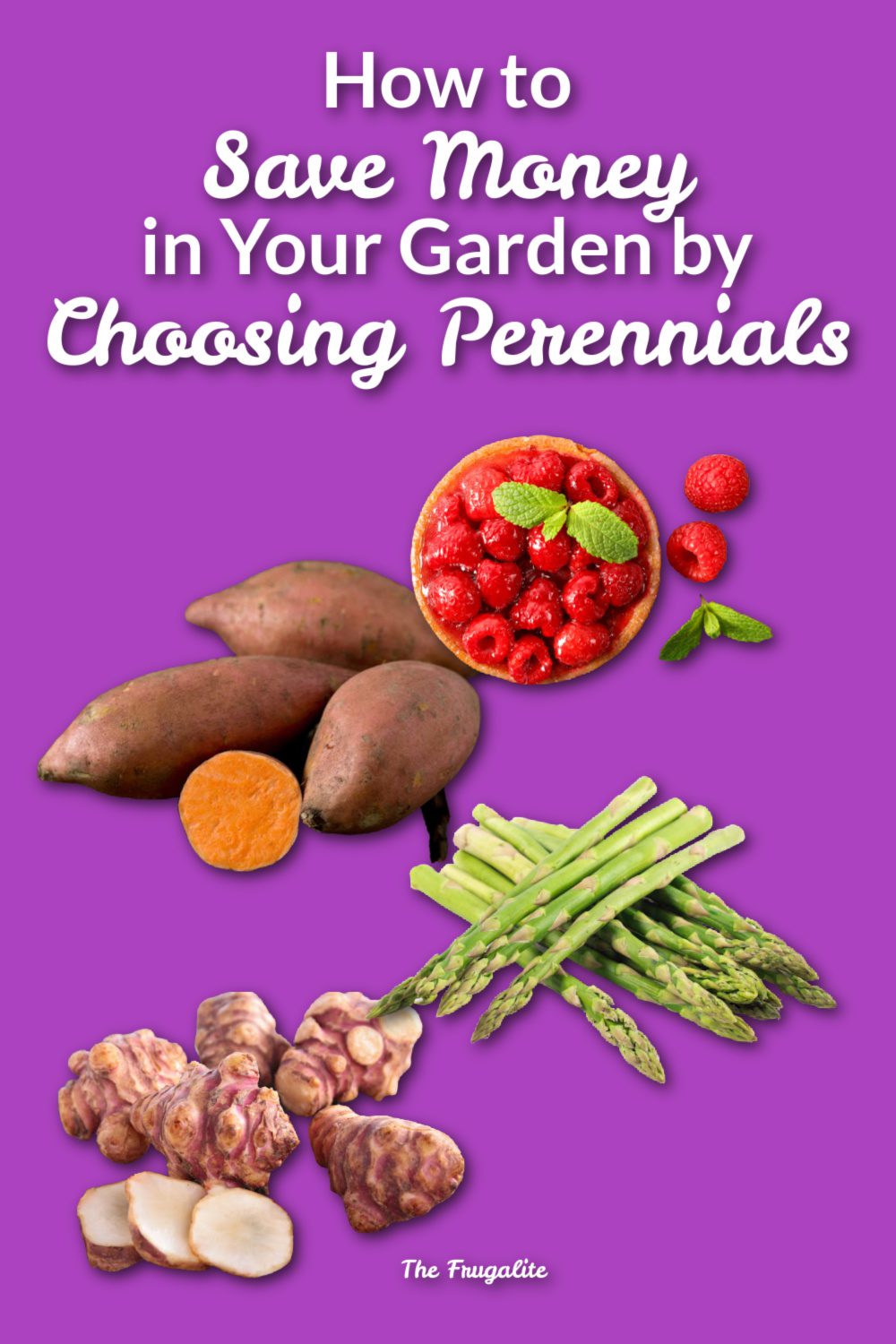(Psst: The FTC wants me to remind you that this website contains affiliate links. That means if you make a purchase from a link you click on, I might receive a small commission. This does not increase the price you’ll pay for that item nor does it decrease the awesomeness of the item. ~ Daisy)
By the author of The Faithful Prepper and Zombie Choices.
We’ve talked in the past about how gardening can save you money on your monthly grocery bill. As I read over the works of Rick Austin, though, I can’t help but wonder: are there even cheaper ways to get your garden up and running? Can you save money by planting perennials?
I think so, and here’s why:
You only have to buy perennials once.
Which is cheaper: to spend $70 on seeds every year for a decade, or to spend $400 on Year 1 and then only spend $10 on seeds every year? There is something of an apples-to-oranges comparison with this, but if we reserve ourselves to comparing perennials versus annuals, I think that this line of thinking makes a lot of sense.
If I put up an additional investment the first year, then I can still end up with a comparable amount of food production each season, but I don’t have to continue to put that massive seed money upfront every year.
The caveat I’ll give here is that many perennials take 2-3 years to really start producing an appreciable level of food. You can grow a lot of foods via annuals during that time frame. But, once those perennials get established and start producing food, they’re hard to beat when it comes to economy.
Don’t forsake annuals altogether.
You still need them. I don’t know where beans, lettuce, and spinach grow as perennials, but it’s not in my area – and I still enjoy eating these. If you solely focus on annuals in your garden (which is absolutely fine, by the way), you’re going to end up spending a significant amount of additional money compared to the guy who’s growing perennials in his garden.
I think that author Rick Austin does a fantastic job of outlining just how this looks. He took his home and converted the surrounding land into his “food forest.” It took a lot of work and investment up front, but now, his garden seems to virtually run itself.
What are some examples of perennials that can save you money in your garden?
This is largely going to depend on your region. The Floridian is going to have a different set of perennials than is the homesteader in North Dakota. Learn what grows well in your region that is edible. Then, use that knowledge to improve the cost-efficiency of your garden.
As a whole, though, the following ideas will serve the bulk of Americans well.
Fruit trees
Fruit trees are a fantastic investment. I first learned about the economy of fruit trees by reading Ben Faulk’s The Resilient Farm and Homestead. Have you ever lived anywhere where an apple or pear tree was present? How many bushels’ worth of fruit were you able to pick from that one tree every year?
Was it at least the $70 or so that you spent on the tree when you planted it? Most people I know with fruit trees actually end up giving away much of their produce simply because it’s too much both for them to eat and to process.
It doesn’t matter the fruit tree (of course, it has to be something that will actually grow in your area). What matters is that a fruit tree can easily pay for itself the very first year you’re able to harvest fruit.
Nut trees
Trees take a long time to mature, but when they finally do, the amount of food that they generate is extraordinary. The bonus here is that tree nuts are very expensive at grocery stores. Walnuts and pecans are the two main nuts that I’m thinking about here (cashews and pistachios require too much work, from my understanding).
I used to be able to harvest 5-gallon buckets full of black walnuts all season long every year at one former property. That’s what you’re looking at here. If I just look at the amount of minerals given, the number of calories given, or the pounds of food given comparing a nut tree versus an annual garden plot, the nut tree is going to win every time (there are variables at play here, but overall, the winner is the nut tree).
Grapevines
How much jam and jelly do you eat on a normal basis? How many pounds of grapes do you buy for your family throughout the course of the year? Could you save money by producing your own with one initial investment?
I think the answer to this last question is an easy ‘yes.’ Granted, traditional grapes don’t grow as well in my area. Scuppernongs, fox grapes, and muscadines are the main “grape” that grow in my region without anybody having to do any intensive spraying of noxious chemicals.
Personally, I wouldn’t even worry about building a trellis. Just let your grapes climb your trees. That really makes this so that this can be a “one and done” solution to boost the productivity of your garden without having to continually pump as much money into it.
Jerusalem artichoke
These are on my to-do list. Once you plant Jerusalem artichokes, you’ll be set from that point onward for this perennial. These edible tubers spread quite prolifically, making it so that you’ll have a steady supply of tubers for years after you plant your first bunch.
Asparagus
Yet one more pleasantry of spring is the asparagus that it brings. Asparagus takes a few years before you can really start to harvest it, and getting started with an asparagus bed does take a significant amount of garden money, but the end result is well worth it.
Asparagus is not only very prolific, but they spread well too. My current asparagus bed has now set up shop in the adjacent bed, meaning I now have two beds filled with asparagus while having only planted one. I paid around $40 to get set up with my asparagus bed several years ago. I’ve easily made my money off of that single bed by now.
Virtually any type of berry
Strawberries, blackberries, blueberries, elderberries – they all come back year after year. Furthermore, berries are a very expensive produce at the grocery store. At least with blackberries and strawberries (in my experience), these really like to spread as well, meaning that your initial investment is only going to grow.
Perennials in your garden can save you money.
Part of the fun of gardening is getting to experiment with new plants. I also look forward to planting carrots every spring, despite my having to buy seed packets every year. However, it’s not the spending money that’s the fun part of gardening, it’s the harvest, and if you are on a very tight budget and still want to have food being produced on your land, perennials are the way to go.
But what are your thoughts on the subject? Are there other perennials you would recommend to help the gardener to save money in the long run? Are there other means by which perennials can save you money? Let us know in the comments below.
About Aden
Aden Tate is a regular contributor to TheOrganicPrepper.com and TheFrugalite.com. Aden runs a micro-farm where he raises dairy goats, a pig, honeybees, meat chickens, laying chickens, tomatoes, mushrooms, and greens. Aden has two published books, The Faithful Prepper and Zombie Choices. You can find his podcast The Last American on Preppers’ Broadcasting Network.

















4 thoughts on “How to Save Money By Planting Perennials in Your Garden”
If a person starts saving seed from annuals as well as replanting kitchen scraps they can start seeing their gardening costs go down even more.
For example: You could grow strawberries (another perennial) and save seeds from pumpkins, peppers and tomatoes. I have started harvesting seed from organic heirloom produce I get at the store. Last year I grew blue potatoes using organic ones I bought for about a third the price of actual seed potatoes, maybe less. And when I eat green onions I replant the ends.
Compost the scraps you can’t re-plant, and you get free dirt – that way you make your garden even cheaper. Good idea about trees and bushes though, they are fantastic perennials. There are also fruit bearing cacti for my fellow desert dwellers!
I save my seeds every year, and don’t have to buy or worry about getting them before they’re gone. I’m saving more money than ever because the price of seeds has gone up along with everything else.
As for growing perennials, remember that you’re unlikely to see a return on your investment for 3-6 years. I’ve yet to see a single plum from trees I planted nearly ten years ago. My strawberries just started producing well when the leather rot took them, and I have no idea why two asparagus beds simply didn’t come back the next year. This stuff isn’t as easy as just dropping seeds on the ground and telling them to grow (Xanth fans will recognize the reference.)
For a lot of practical gardening info, check out David the Good’s Survival Gardening website & YouTube channel. Lots of information on planting, composting, building better soil, permaculture.
If you are really interested in perennials for your area you need this book. (See link below.)
I am in zone 4 and was pleasantly surprised by what I could grow. Wish I could grow more but I do what I can do and thats it. In the back it has everything listed by area and then you can get more in-depth information from the beginning of the book.
https://www.amazon.com/Perennial-Vegetables-Artichoke-Easy-grow/dp/1931498407/ref=nodl_?dplnkId=0887ba52-f1d0-4ffc-99e7-dc303db5b6a3